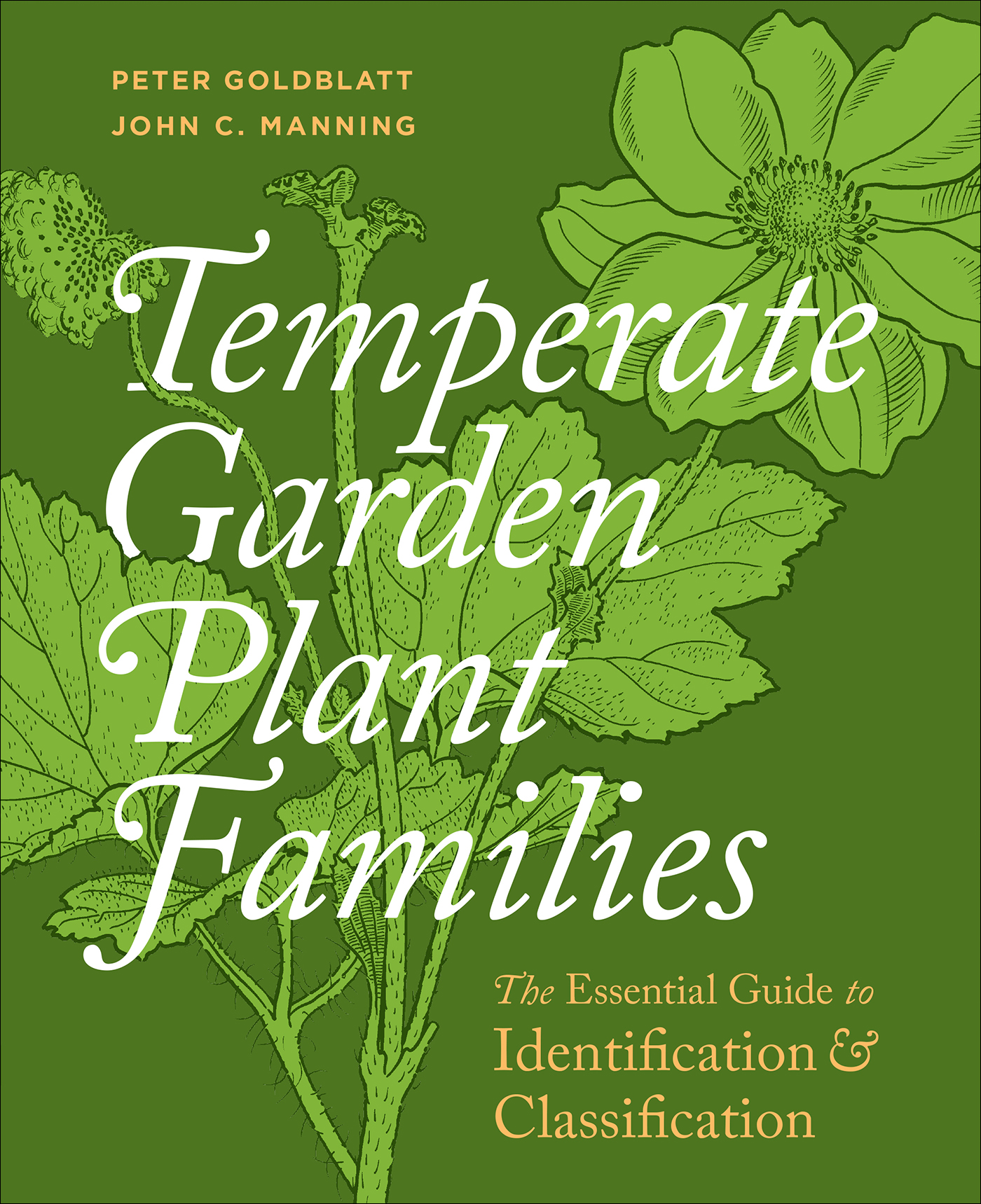Peter Goldblatt - Temperate Garden Plant Families
Here you can read online Peter Goldblatt - Temperate Garden Plant Families full text of the book (entire story) in english for free. Download pdf and epub, get meaning, cover and reviews about this ebook. year: 2019, publisher: Timber Press, genre: Home and family. Description of the work, (preface) as well as reviews are available. Best literature library LitArk.com created for fans of good reading and offers a wide selection of genres:
Romance novel
Science fiction
Adventure
Detective
Science
History
Home and family
Prose
Art
Politics
Computer
Non-fiction
Religion
Business
Children
Humor
Choose a favorite category and find really read worthwhile books. Enjoy immersion in the world of imagination, feel the emotions of the characters or learn something new for yourself, make an fascinating discovery.

- Book:Temperate Garden Plant Families
- Author:
- Publisher:Timber Press
- Genre:
- Year:2019
- Rating:5 / 5
- Favourites:Add to favourites
- Your mark:
- 100
- 1
- 2
- 3
- 4
- 5
Temperate Garden Plant Families: summary, description and annotation
We offer to read an annotation, description, summary or preface (depends on what the author of the book "Temperate Garden Plant Families" wrote himself). If you haven't found the necessary information about the book — write in the comments, we will try to find it.
Temperate Garden Plant Families — read online for free the complete book (whole text) full work
Below is the text of the book, divided by pages. System saving the place of the last page read, allows you to conveniently read the book "Temperate Garden Plant Families" online for free, without having to search again every time where you left off. Put a bookmark, and you can go to the page where you finished reading at any time.
Font size:
Interval:
Bookmark:

Peter Goldblatt and John C. Manning
Timber Press
Portland, Oregon
This book is primarily addressed to gardeners, horticulturists, and plant enthusiasts working with plants of temperate climates, thus plants that are hardy or half-hardy. It is not encyclopedicmany families are not be dealt with because they are entirely tropical in distribution or mostly not in cultivation in temperate gardens. It is intended as an introduction to the concept of plant families, especially in light of the more recent changes in the circumscription of many families and the nomenclature of plants at the level of family, genus, and species.
Sources of primary information include first and foremost Mabberleys Plant-Book, Fourth Edition (Mabberley 2017), which treats all families and genera according to the most current classification. Wikipedia provided useful ancillary material. Families are recognized and circumscribed largely following the recommendations of the Angiosperm Phylogeny Group (APG) in its latest publications (APG 2003, 2009), the former offering some alternative treatments. We include several modifications to the APG classification as suggested by later authors. Taxonomy of Vascular Plants (Lawrence 1951), though arranged according to an out-of-date classification, is nevertheless a source of invaluable details about many plant families. Specialized terms are defined in the Glossary. Additional sources of useful information are included in the References.
Many colleagues helped us refine our entries for families not well known to us: Ihsan Al-Shehbaz (Brassicaceae), Peter Bruyns (Apocynaceae), Peter Hoch (Onagraceae), Cornelia Klak (Aizoaceae), Peter Linder (Poaceae), P. P. Lowry II (Araliaceae), Anthony Magee (Apiaceae), Deirdre Snijman (Amaryllidaceae), and Charlotte Taylor (Rubiaceae). We thank Carmen Ulloa Ulloa for her photographs of Viola pygmaea.
What are plant families you ask? The word family means different things to different people. To biologists, families are a formal and specific rank of classification. Families include a number of genera that share characteristics and are known or believed to be related to one another more closely than to genera of other families.
For the nonscientist it seems legitimate to ask, Why develop a knowledge of plant families at all? In a broad sense it provides a framework for thinking about plants and for arranging hundreds or even thousands of plant names in a coherent and predictive pattern. Knowledge of plant families also allows the reader to develop a deeper understanding of the plants you grow and love. No, knowledge of plant families will not make you a better gardener, but it will provide a deeper appreciation of the plant world and the plants you cultivate. Do you love primulas and primroses, members of the genus Primula? Well then, you will surely be fascinated to know that shooting stars, the genus Dodecatheon, belong to the same family, Primulaceae. Cyclamens, the genus Cyclamen, are also members of the Primulaceae. This may give you pause, Why? Look at the arrangement of the flowersboth primulas and shooting stars have flowers clustered together at a single point on the stem, an arrangement called an umbel. Also, the petals are joined together at the base, and the fruits are more or less identical to those of cyclamens. The fruits are dry and of the type known technically as capsules, and in these genera they split open in a circle near the top of the ripe fruit, a feature rare or absent in other plant families. The genus Lysimachia, which includes gooseneck loosestrife, yellow loosestrife, and creeping jenny among others, has similar capsules, but often the flowers are arranged in different ways on the stem. And as common names go, they are often confusing. Thus purple loosestrife is a member of a different family, Lythraceae (the loosestrife or crepe myrtle family); common names are frequently a poor guide to family relationships.
Many other Primulaceae are trees, most of them tropical, and so temperate gardeners have probably never heard of them. A recurring theme in many plant families is that their tropical members are trees that do not survive in winter-cold temperate gardens. We mostly grow only the cold-tolerant perennial members of these families and seldom their woody relatives.
How much deeper ones appreciation of plants becomes as these patterns are revealed. Perhaps more fascinating than the primulashooting starcyclamen example is that jasmines and lilacs are olives, or at least all belong in the olive family, Oleaceae. Once again, look at the flowers: jasmines, lilacs, and olives all have four petals partly united in a tube or cup, with the free portions spreading above, and they all have just two stamens (the male portion of the flower). Also, the fruits of jasmines (the genus Jasminum) and olives (Olea) are structurally similar, fleshy with a hard inner stone containing a single seed. Lilacs (Syringa) have just such flowers too (some doubled cultivars excepted) but quite different fruits, dry capsules that split vertically into sections and, to the dismay of many, persist untidily on the branches through the winter months. Many other plant families have flowers with petals partly united but differ in other features, for example, more stamens, or different kinds of fruits, or a more complex arrangement of the petals.
The example of the honeysuckle family Caprifoliaceae shows another aspect of an understanding of plant families and their relationships. Caprifoliaceae include not only climbing honeysuckles (Lonicera species) but also shrubs and small trees such as abelia (the genus Abelia), beauty bush (Kolkwitzia), and weigelia (Weigela) to name some. Elderberry (Sambucus) and viburnum (Viburnum), often included in Caprifoliaceae, are classified as a separate family, Viburnaceae. These share similar small flowers with five petals, five (or fewer) stamens, an inferior ovary (the calyx and corolla are inserted at the top of the ovary), and leaves in pairs opposite one another. In a more recent development in family classification, perennials such as scabious or pincushion flower (Scabiosa) and valerian (Valeriana) are regarded as members of the honeysuckle family. Historically, these herbaceous plants have been assigned to two other families, Dipsacaceae and Valerianaceae, respectively, but their flowers match exactly those of most other honeysuckles, and they have opposite leaves, as do honeysuckles. The close relationship of these families is corraborated by molecular genetic studies.
From these examples, it is evident then that important criteria for recognizing plant families include the number of petals (and sepals), the union or not of the petals, the number of stamens, and the position of the ovary in relation to the petals and sepals. Other features that may be important are division of the leaves (simple, or compound and comprising several leaflets) and their arrangement on the stem (either opposite or alternate, or more correctly in spirals, or sometimes in whorls). Fruits may also be important, but often less so. In the rose family (Rosaceae) fruits may be fleshy drupes (peaches, cherries), berries (raspberries), pomes (apples, pears), or dry capsules (as in spiraeas).
Font size:
Interval:
Bookmark:
Similar books «Temperate Garden Plant Families»
Look at similar books to Temperate Garden Plant Families. We have selected literature similar in name and meaning in the hope of providing readers with more options to find new, interesting, not yet read works.
Discussion, reviews of the book Temperate Garden Plant Families and just readers' own opinions. Leave your comments, write what you think about the work, its meaning or the main characters. Specify what exactly you liked and what you didn't like, and why you think so.









